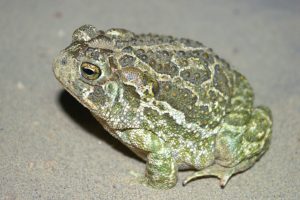
By
Pamela Rutherford, Alyssa Eagle, and Shawna Philpott
May 2017
Print Version
What you need to know
We are studying the effects of roads on amphibian and reptile populations in southwestern Manitoba. Of all ecosystems, wetlands are the most impacted by roads because roads destroy wetland habitat and/or force animals to move across roads to access wetlands for breeding and foraging during spring and fall migration periods. Unfortunately, there are many reports of roads being completely covered with dead animals during spring and fall migration periods. Our research will help identify these areas in Manitoba and work with Manitoba Infrastructure to implement strategies to mitigate these effects.
Why this research is important
This research is important because we can identify regions or ‘hotspots’ in Manitoba where there is high mortality and/or high impacts on roadside wetlands. We are focusing our efforts on four species that are of conservation concern because of their declining populations: (1) Great Plains Toad, (2) Northern Leopard Frog, (3) Common Snapping Turtle, and (4) Western Tiger Salamander. Amphibians and reptiles are considered one of the most at-risk groups of animals, and unfortunately, many populations continue to decline due to loss of habitat, climate change, and other impacts by humans.
How the research is being done
For this this research study we monitor amphibian and reptile activity along roads in southwestern Manitoba. We conduct breeding surveys in the spring by working at night and recording any males that are calling (each species has a unique call and males call to attract a mate). We also collect data on animals that are found on the roads (either dead or alive) and in the roadside ponds. In addition, we collect information on the water quality of the roadside ponds to determine if they are healthy habitats for all plants and animals. We also use data from the Manitoba Herp Atlas http://www.naturenorth.com/Herps/Manitoba_Herps_Atlas.html and ArcGIS (geographic information system for working with maps and geographic information) to determine ‘hotspots’ of activity for reptiles and amphibians throughout Manitoba.
What the researchers found
To date, we have located two ‘hotspots’ of activity along roads in Manitoba: (1) around Melita in southwestern Manitoba and (2) around Tolstoi in southeastern Manitoba. These ‘hotspots’ include three of the species that are of conservation concern: (1) Northern Leopard Frog, (2) Great Plains Toad and (3) Western Tiger Salamander. We are continuing the research this summer, with the assistance of Manitoba Infrastructure, and will be conducting detailed analyses of wetlands in these regions.
How this research can be used
Using this information we can work with Manitoba Infrastructure to implement strategies to mitigate these effects that can be used throughout Manitoba. These strategies will help to ensure that roadside ponds are providing healthy habitat for all plants and animals, and that mass mortality of migrating animals during spring and fall is minimized.
We thank the following organizations for provided funding and support for this research: Manitoba Infrastructure, Manitoba Sustainable Development, Manitoba Graduate Scholarship, BURC, Brandon University Student Union, Canada Summer Jobs, and Lake Winnipeg Research Consortium.
About the Researchers
Keywords
- amphibian
- conservation
- reptile
- wetlands
Publications Based on the Research
Rutherford, P. L., Eagle, A., & Philpott, S. (2017). Amphibian Protection. Technical Report provided to Manitoba Infrastructure. 36. pp.
Editor: Christiane Ramsey
Read more BU Research
Research at Brandon University follows comprehensive policies designed to safeguard ethics, to ensure academic integrity, to protect human and animal welfare and to prevent conflicts of interest.



